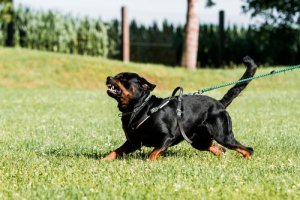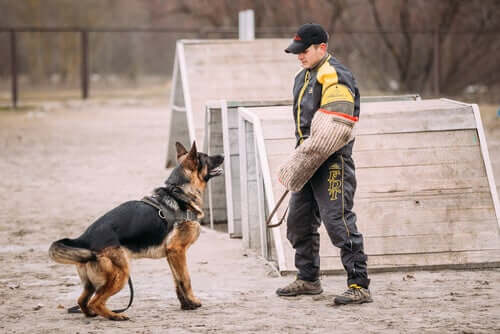Defense and Attack Training in Dogs

Although there aren’t too many guard dogs, there are still people who adopt large animals to protect the house. In fact, even small dogs could learn how to do this. We’ll tell you how to carry out defense and attack training in dogs.
Firstly, we need to emphasize that there’s an important difference between training a dog to guard and training them to attack. Watchdogs might not be prepared to attack, but they can be trained to do so.
In addition, you must be fully aware that the laws and rules for attack dogs might vary depending on your city and state.
We want to emphasize this because when you train dogs to attack, it’s just as important to train them how to stop. If you don’t have control of this, you might be forced to put down the dog. Therefore, make sure you know the regulations for your area.
Defense and attack training in dogs
We’ll show you this procedure in six steps:
Choosing the right dog for defense and attack training
Not all dogs are prepared for this type of training. So, you should make sure you analyze different breeds and choose one you think is best. This doesn’t mean that a crossbred dog won’t work, but this training needs a certain type of temperament.
The most common breeds for defense and attack training are German Shepherds, Belgian Shepherds and Rottweilers. However, there are other dogs that make good guard dogs, like Spanish Mastiffs. In fact, they’re great for protecting flocks. Make sure you talk to a vet or trainer for advice.
An exclusive job for professionals
This training is aimed at keeping third parties safe, because it’s quite possible for them to harm a person. Because of this, professionals are the only ones that should do defense and attack training.

The first thing that the trainer will do is teach basic commands, like sitting, fetching or standing still. The dog will have to learn to obey these commands before learning more complicated ones. That way, they will understand who is in charge and will listen, both when they need to attack and when to stop.
Teach him neutrality
When going through this training, dogs may lose control and not know when to do it. Therefore, it’s important to make them neutral with other people and animals so there aren’t any accidents.
Being too loving is the other extreme, which wouldn’t be good either. Dogs going through defense and attack training should be balanced and not go to extremes. They must be able to ignore everything around them, except their owner’s voice.
Train biting
Only professionals can do this training. Here, they need to teach dogs what body part they should bite, so they don’t do more damage than they should.

In this sense, for their own protection, trainers will wear a special suit so they don’t get hurt. However, at first they’ll start with sticks or branches.
Commands for defense and attack training
Dogs need to associate a keyword to start the attack, and another to stop. Both are important, so you’ll have to choose a short word and remember it for each action.
Positive reinforcement
If you want to teach your dog just to defend, the best thing is positive reinforcement. This is where you reward the dog for doing things you asked him to. This way, they’ll relate obedience with things they like, like treats. On the other hand, punishments will only break the trust between you and your dog.
As you can see, defense and attack training in dogs is somewhat delicate. It’s important to follow these steps. Also, make sure you have a professional’s help in order to ensure everyone’s safety. Don’t forget to use positive reinforcement. Your dog will be happier when they get well-deserved treats. When they earn their retirement- after about 7 years- they’ll also be a perfect family dog.
Although there aren’t too many guard dogs, there are still people who adopt large animals to protect the house. In fact, even small dogs could learn how to do this. We’ll tell you how to carry out defense and attack training in dogs.
Firstly, we need to emphasize that there’s an important difference between training a dog to guard and training them to attack. Watchdogs might not be prepared to attack, but they can be trained to do so.
In addition, you must be fully aware that the laws and rules for attack dogs might vary depending on your city and state.
We want to emphasize this because when you train dogs to attack, it’s just as important to train them how to stop. If you don’t have control of this, you might be forced to put down the dog. Therefore, make sure you know the regulations for your area.
Defense and attack training in dogs
We’ll show you this procedure in six steps:
Choosing the right dog for defense and attack training
Not all dogs are prepared for this type of training. So, you should make sure you analyze different breeds and choose one you think is best. This doesn’t mean that a crossbred dog won’t work, but this training needs a certain type of temperament.
The most common breeds for defense and attack training are German Shepherds, Belgian Shepherds and Rottweilers. However, there are other dogs that make good guard dogs, like Spanish Mastiffs. In fact, they’re great for protecting flocks. Make sure you talk to a vet or trainer for advice.
An exclusive job for professionals
This training is aimed at keeping third parties safe, because it’s quite possible for them to harm a person. Because of this, professionals are the only ones that should do defense and attack training.

The first thing that the trainer will do is teach basic commands, like sitting, fetching or standing still. The dog will have to learn to obey these commands before learning more complicated ones. That way, they will understand who is in charge and will listen, both when they need to attack and when to stop.
Teach him neutrality
When going through this training, dogs may lose control and not know when to do it. Therefore, it’s important to make them neutral with other people and animals so there aren’t any accidents.
Being too loving is the other extreme, which wouldn’t be good either. Dogs going through defense and attack training should be balanced and not go to extremes. They must be able to ignore everything around them, except their owner’s voice.
Train biting
Only professionals can do this training. Here, they need to teach dogs what body part they should bite, so they don’t do more damage than they should.

In this sense, for their own protection, trainers will wear a special suit so they don’t get hurt. However, at first they’ll start with sticks or branches.
Commands for defense and attack training
Dogs need to associate a keyword to start the attack, and another to stop. Both are important, so you’ll have to choose a short word and remember it for each action.
Positive reinforcement
If you want to teach your dog just to defend, the best thing is positive reinforcement. This is where you reward the dog for doing things you asked him to. This way, they’ll relate obedience with things they like, like treats. On the other hand, punishments will only break the trust between you and your dog.
As you can see, defense and attack training in dogs is somewhat delicate. It’s important to follow these steps. Also, make sure you have a professional’s help in order to ensure everyone’s safety. Don’t forget to use positive reinforcement. Your dog will be happier when they get well-deserved treats. When they earn their retirement- after about 7 years- they’ll also be a perfect family dog.
All cited sources were thoroughly reviewed by our team to ensure their quality, reliability, currency, and validity. The bibliography of this article was considered reliable and of academic or scientific accuracy.
- Agencia Estatal Boletín Oficial del Estado. (2011) Real Decreto 1037/2011. Recuperado el 13 de febrero de 2022, disponible en: https://www.boe.es/buscar/doc.php?id=BOE-A-2011-14249
This text is provided for informational purposes only and does not replace consultation with a professional. If in doubt, consult your specialist.








